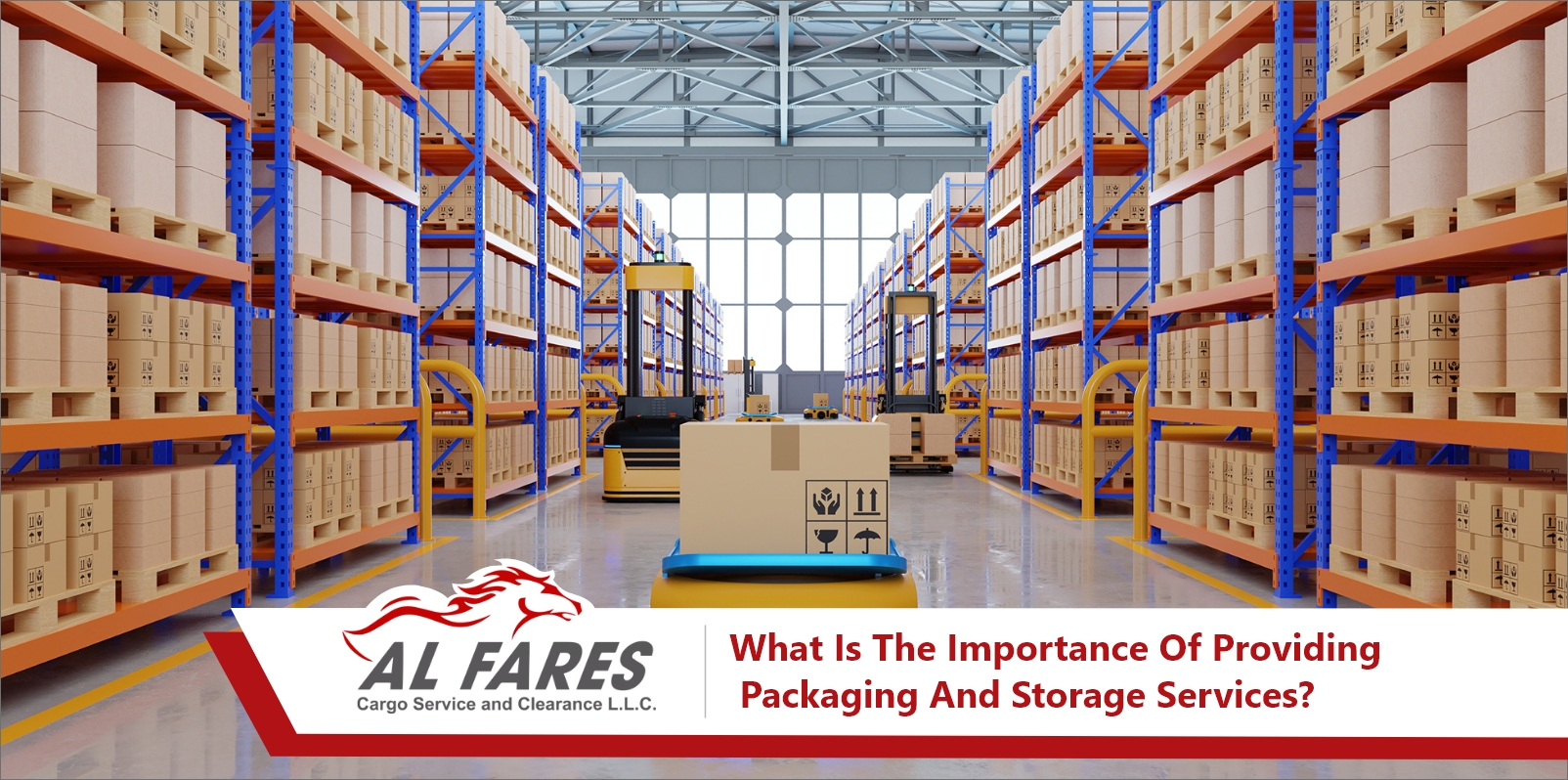Shipping companies are among the key players that have a vital role in the smooth movement of goods and their delivery to their intended destinations. One of the most important elements of success for these companies is the efficient and secure provision of packaging and storage services. When it comes to delivering shipments and goods to customers, the quality of packaging and storage plays a crucial role in preserving their safety and quality.
Providing good packaging services means that shipments or goods will be effectively protected during transport and handling. When items are packed correctly and suitable materials are used, they are shielded from shocks and vibrations that occur during transit, reducing the likelihood of damage or product deterioration. Additionally, proper packaging facilitates unloading and loading processes, saving time and effort for logistics companies.
What Do We Mean by Packaging and Storage Services?
Packaging and storage services in shipping companies refer to the processes and activities performed by these companies to effectively package goods and provide efficient storage for them during transportation and distribution phases. These services include a range of activities aimed at protecting and preserving the safety of goods during transport and ensuring a suitable storage environment to maintain their safety and quality. Here are some details about these services:
- Packaging: The packaging process involves selecting the appropriate materials to package shipments and protect them from damage during transportation. Suitable materials are chosen based on the nature, size, and type of goods. Proper packaging aims to shield goods from shocks, vibrations, and damage during transit.
- Shipment Delivery: Packaging and storage services also include the processes of delivering goods from their source to their intended destination. These processes involve loading goods onto the appropriate means of transportation, whether it's trucks, sea containers, or others. Loading should be done carefully to ensure the stability of shipments and prevent any damage or breakage.
- Storage: After shipments reach warehouses or logistics centers, storage services are provided to store goods safely and in an organized manner. These services involve identifying designated spaces for storing goods and organizing them in a way that facilitates sorting and preparation for shipment. Advanced inventory management systems and tracking techniques are used to effectively monitor and control the movement of goods.
- Preserving Shipment Quality: Packaging and storage services are also responsible for preserving the quality of goods during storage periods, requiring the provision of suitable storage conditions.
- Repackaging and Reworking: In some cases, logistics companies may offer repackaging and reworking services. This is done to meet the needs of customers who require different packaging or reworking of goods to meet market requirements or improve distribution processes.
- Inventory Management and Shipment Tracking: Inventory management and shipment tracking are essential parts of packaging and storage services. Inventory management systems and tracking techniques are used to monitor the movement of goods and manage inventory effectively. Customers are also provided with up-to-date information about the status and location of their shipments and the expected delivery time.
Steps for Packaging Shipments:
The process of packaging a shipment in shipping companies involves several steps to ensure that the shipments are properly protected during transport. These are the general steps involved in the shipment packaging process:
- Assessment of the Shipment: The shipment is assessed to understand its nature and potential packaging requirements. Factors like size, weight, type of materials, and specific characteristics are studied to ensure the selection of appropriate packaging materials.
- Selection of Appropriate Materials: Suitable materials for packaging the shipment and protecting it are chosen. These materials may include cartons, boxes, plastic bags, bubble wrap, protective films, and adhesive tapes. The materials selected should be tailored to the size and shape of the shipment, providing the necessary protection.
- Preparing the Shipment: The shipment is prepared for packaging by cleaning, drying, and securing it. Any parts that are susceptible to damage or breakage should be removed before packaging. This may involve separating breakable components or securing movable parts.
- Packaging the Shipment: The shipment is placed inside the appropriate packaging materials and securely fastened. Adhesive tapes are used to secure the sides and edges, and bubble wrap or protective films are used to shield the shipment from shocks and vibrations.
- Labeling and Tagging: Appropriate labels and tags must be applied to the shipment to identify its nature and ensure proper handling. Labels may include information about weight, size, content, and instructions for handling the shipment.
- Securing and Fastening: The shipment should be properly secured inside the transportation vehicle. Strapping, wooden pallets, or restraints may be used to ensure the stability of the shipment during transport, preventing any sliding or unwanted movement.
- Documentation of the Shipment: Details related to the shipment, including weight, size, quantity, and value, should be documented. Necessary documents, such as shipping invoices and identification cards, are prepared.
- Review of the Shipment: Before shipping the shipment, a final review is conducted to ensure that all the previous steps have been properly completed. It is essential to confirm that the shipment is well-packaged, adequately protected, and ready for transport.
Storage Methods in Shipping Companies:
Shipping companies employ various storage methods to ensure inventory organization and safety. Here are some common storage methods used in these companies:
- Shelf Storage: Products are stored on dedicated shelves in warehouses. Products are organized and arranged on shelves in an orderly manner according to a specific system, such as categorizing products by class, size, code, or expiration date.
- Pallet Racking: Products are stacked in large warehouses. They are placed in vertical rows with multiple layers to maximize storage space and increase storage efficiency. Forklift systems may be used to access products in higher layers.
- Dock Storage: Products are stored on pallets or docks. Pallets are stacked vertically, allowing products to be accessed using forklifts. This type of storage provides ease of access to products and maneuverability.
- Container Storage: Products are stored inside large containers that are moved by forklifts or specialized equipment. This method is used for collective storage of large-sized products or goods packed in standard containers.
- Specialized Storage: Products with special characteristics or sensitivity are stored in specially equipped warehouses to ensure product quality. These warehouses may include temperature-controlled environments, protection from moisture, dust, and harsh lighting, and appropriate security and monitoring systems.
The Importance of Packaging and Storage Services:
Packaging and storage services play a crucial role in shipping and logistics operations and hold significant importance for both companies and customers. Here are some key aspects of their importance:
1-Product Protection:
Proper packaging services provide protection for products during transportation and storage. Appropriate packaging materials, such as cardboard, bubble wrap, and protective packaging, are used to reduce the risk of damage or deterioration during handling and transit.
2-Inventory Organization:
Storage services help in organizing and categorizing inventory in an orderly manner. Specific locations and systems are allocated for storing goods based on their characteristics, such as size, weight, or classification, making it easier to locate products and improve operational efficiency.
3-Enhanced Delivery Efficiency:
Good storage services can enhance delivery efficiency. When inventory is well-organized and efficiently managed, it reduces loading and unloading times and speeds up the distribution of products to customers.
4-Order Management:
Quality storage services centralize inventory management and order processing. Storing inventory in a centralized location allows for effective order and shipment management, making it easier to track, update, and meet customer needs.
5-Time and Cost Savings:
Specialized packaging and storage services can save time and costs. Proper packaging reduces the risk of damage and returns, lowering repair and replacement expenses. Furthermore, optimizing shipping and delivery processes can save time and expenses associated with transportation and storage.


 Track Your Shipment
Track Your Shipment
 Online Enquiry
Online Enquiry
 Sign In
Sign In
 English
English

 Alfares Cargo
Alfares Cargo
 Logistic Informations
Logistic Informations
 2023-11-06
2023-11-06












